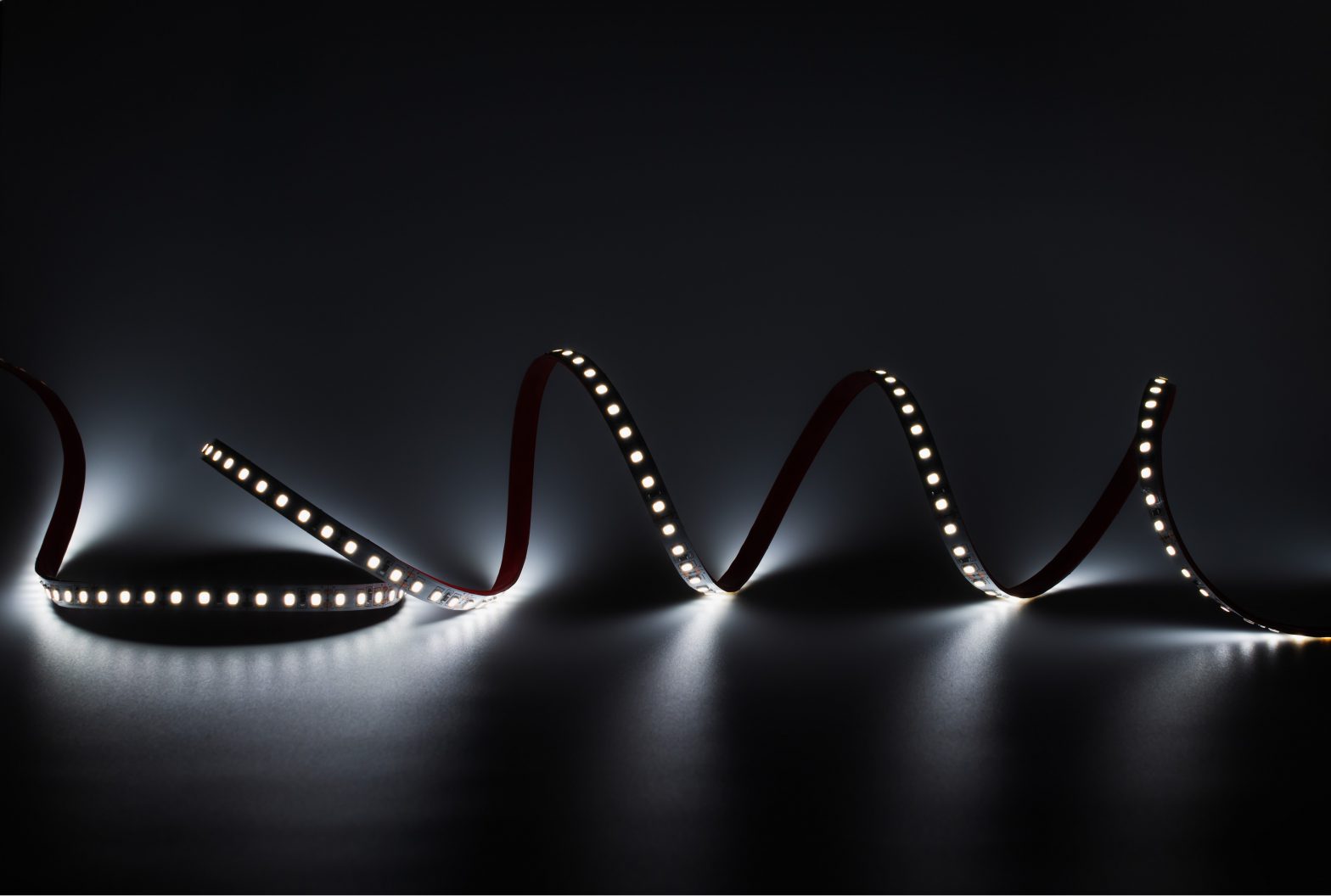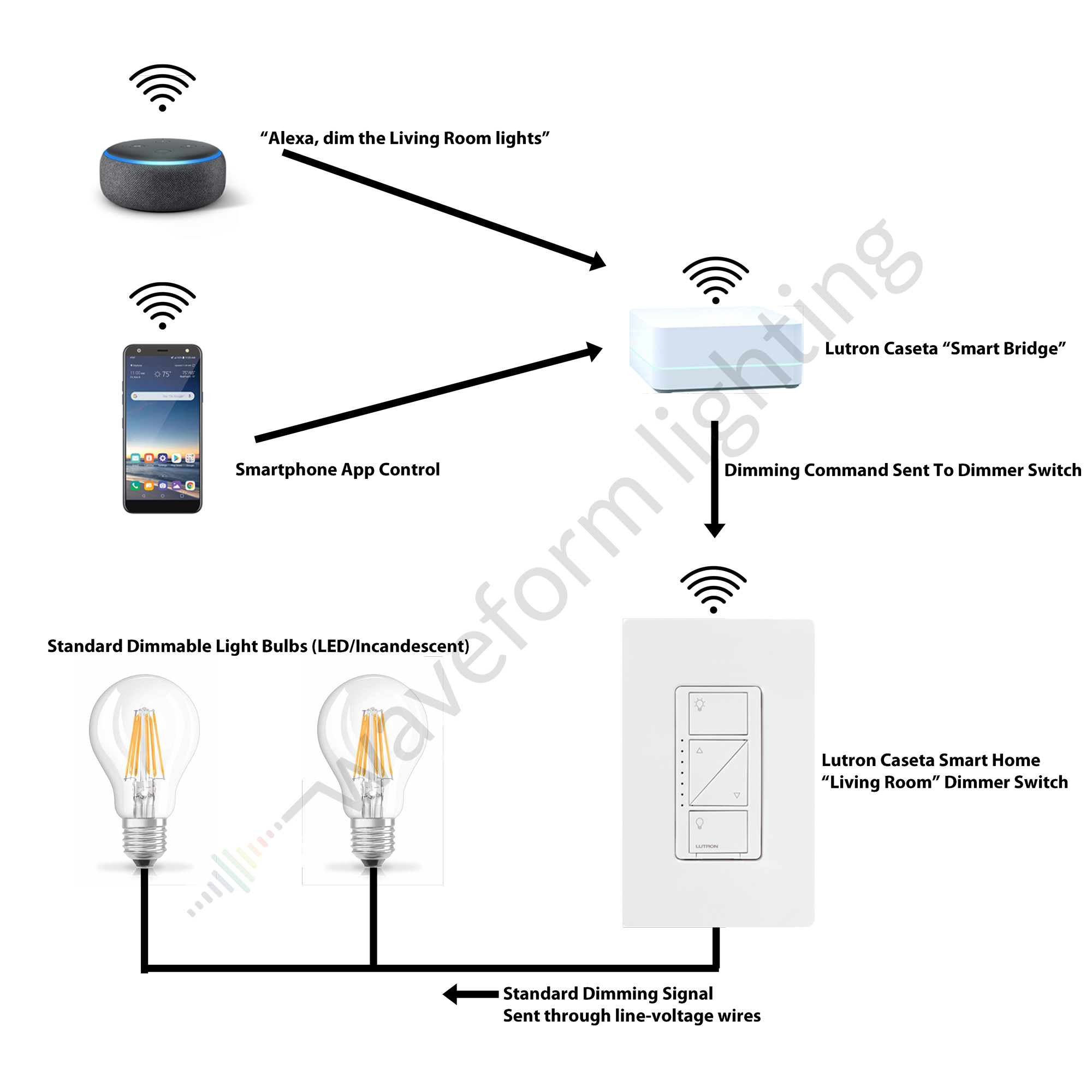
Dimming LED Strip Lights and LED Bulbs using Smart Lighting Systems
Home /
Blog /
Home & Residential /
Dimming LED Strip Lights and LED Bulbs using Smart Lighting Systems
In recent years, there has been a rapid growth in smart lighting systems that allow users to control their lights via smartphone apps and home assistants such as Google Home, Amazon Alexa.
Alongside this growth in smart devices has been an equally rapid growth in LED lighting technologies. The ability to control novel lighting systems using a smartphone or by voice is a very exciting technological development. At times, however, it can be quite challenging for the end consumer to implement, as lighting manufacturers and smart device manufacturers do not always design products that are compatible with each other.
In this article, we go over the basic principles behind connecting single-color low voltage LED strip lights to a smart lighting system such as Lutron Caseta, which in turn can be controlled via smartphone apps and voice-activated systems such as Google Home and Amazon Alexa.
The majority of light bulbs on the market today, including cutting-edge LED bulbs, are not designed to be connected to the internet. Therefore, there is no communications link between the light bulbs and the outside world, other than the physical electrical switch.
There are several "smart" light bulbs that essentially have a built-in WiFi transceiver inside of the light bulb. These bulbs have the ability to connect to the local WiFi network so that apps and home assistant systems can control them. Some popular options you may have encountered before include products such as the Philips Hue light bulb.
Because each bulb is "smart," individual commands can be sent to individual bulbs, and the individual bulbs will react the those commands. (For example, you can say "Alexa, dim the bedroom light bulb.")
The idea behind smart lighting systems such as Lutron Caseta is to allow standard light bulbs to be controlled by a "smart" system. In other words, it is a way to control regular light bulbs (including incandescent and LED bulbs) that have no "smart" WiFi capability using a smartphone or voice command.

The way this is accomplished is by embedding the WiFi capability into the dimmer switch itself, rather than into each individual light bulb, as is the case with "smart bulbs" such as the Philips Hue bulb. The Lutron Caseta system essentially creates a "smart circuit" that allows the on, off and dimmer settings for a specific electrical circuit be controlled via a smartphone app or voice command.
The bulbs (or as we discuss below, the LED strip circuits) themselves remain the same and do not require any special modification or changes. They simply react to the on, off, and dimmer signals output by the Lutron Caseta system, and are not even aware whether the commands have originated by a smartphone, voice command or manual wall-switch adjustment.
Unlike traditional light bulbs which operate on 120V AC line voltage (or 220/240V AC outside of North America), LED strip lights operate at 12V or 24V DC. This introduces some complexities in dimming methods, which we discuss in depth here.
In short, if you are looking to dim LED strip lights using a smart home system such as Lutron Caseta, you will need to use a dimmable power supply. The dimmable power supply's function is to convert line voltage (120V AC) to low voltage DC (12V/24V DC), and simultaneously interpret the dimming signal provided by the "Smart Home" dimmer switch, and convert it to the corresponding low voltage DC dimming signal appropriate for the LED strip lights.
Be aware that the Lutron Caseta system works only with single color LED strip lights, and only provides brightness control. If you are looking for something to work with color changing lights such as RGB LED strip lights, you will need to look for an alternative approach.
Furthermore, finding a dimmable power supply can be tricky, and not all dimmable power supplies are compatible with the Lutron Caseta system. Check out the dimmable power supply manufacturer's list of compatible dimmers, and confirm if the Lutron Caseta dimmer is listed. Furthermore, check to ensure that the dimming range is sufficient for your needs. In some cases, the Lutron Caseta dimmer will simply not "play nice" with the dimmable power supply, and you may run into unforeseen compatibility issues.
Waveform Lighting's TRIAC dimmable power supplies + 95 CRI LED strip lights have been tested extensively to work with Lutron Caseta's system, via both the Lutron smartphone app as well as voice-controlled apps such as Amazon Alexa and Google Home. The dimming range was tested to be 0.2%-100%.
Alongside this growth in smart devices has been an equally rapid growth in LED lighting technologies. The ability to control novel lighting systems using a smartphone or by voice is a very exciting technological development. At times, however, it can be quite challenging for the end consumer to implement, as lighting manufacturers and smart device manufacturers do not always design products that are compatible with each other.
In this article, we go over the basic principles behind connecting single-color low voltage LED strip lights to a smart lighting system such as Lutron Caseta, which in turn can be controlled via smartphone apps and voice-activated systems such as Google Home and Amazon Alexa.
How does a smart lighting system such as Lutron Caseta work?
The majority of light bulbs on the market today, including cutting-edge LED bulbs, are not designed to be connected to the internet. Therefore, there is no communications link between the light bulbs and the outside world, other than the physical electrical switch.
There are several "smart" light bulbs that essentially have a built-in WiFi transceiver inside of the light bulb. These bulbs have the ability to connect to the local WiFi network so that apps and home assistant systems can control them. Some popular options you may have encountered before include products such as the Philips Hue light bulb.
Because each bulb is "smart," individual commands can be sent to individual bulbs, and the individual bulbs will react the those commands. (For example, you can say "Alexa, dim the bedroom light bulb.")
The idea behind smart lighting systems such as Lutron Caseta is to allow standard light bulbs to be controlled by a "smart" system. In other words, it is a way to control regular light bulbs (including incandescent and LED bulbs) that have no "smart" WiFi capability using a smartphone or voice command.

The way this is accomplished is by embedding the WiFi capability into the dimmer switch itself, rather than into each individual light bulb, as is the case with "smart bulbs" such as the Philips Hue bulb. The Lutron Caseta system essentially creates a "smart circuit" that allows the on, off and dimmer settings for a specific electrical circuit be controlled via a smartphone app or voice command.
The bulbs (or as we discuss below, the LED strip circuits) themselves remain the same and do not require any special modification or changes. They simply react to the on, off, and dimmer signals output by the Lutron Caseta system, and are not even aware whether the commands have originated by a smartphone, voice command or manual wall-switch adjustment.
Connecting smart home systems to dimmable LED strip light systems
Unlike traditional light bulbs which operate on 120V AC line voltage (or 220/240V AC outside of North America), LED strip lights operate at 12V or 24V DC. This introduces some complexities in dimming methods, which we discuss in depth here.
In short, if you are looking to dim LED strip lights using a smart home system such as Lutron Caseta, you will need to use a dimmable power supply. The dimmable power supply's function is to convert line voltage (120V AC) to low voltage DC (12V/24V DC), and simultaneously interpret the dimming signal provided by the "Smart Home" dimmer switch, and convert it to the corresponding low voltage DC dimming signal appropriate for the LED strip lights.
With the dimmable power supply connected to the line voltage circuit controlled by the Lutron Caseta Smart Home dimmer switch, the dimmable power supply can now be controlled and connected to your smartphone or voice controlled smart devices. The dimmable power supply will simply respond to the dimming signal provided by the dimmer switch, and output the corresponding LED strip dimming signal.
While the wiring diagram may appear to look complicated, one simple way to look at this set-up is to see the dimmable power supply + LED strip section as a single unit that is analogous to a traditional light bulb. You can connect additional dimmable power supplies and LED strips to a single Lutron Caseta dimmer switch by connecting the dimmable power supplies in parallel to each other.
Limitations and Component Compatibility
Be aware that the Lutron Caseta system works only with single color LED strip lights, and only provides brightness control. If you are looking for something to work with color changing lights such as RGB LED strip lights, you will need to look for an alternative approach.
Furthermore, finding a dimmable power supply can be tricky, and not all dimmable power supplies are compatible with the Lutron Caseta system. Check out the dimmable power supply manufacturer's list of compatible dimmers, and confirm if the Lutron Caseta dimmer is listed. Furthermore, check to ensure that the dimming range is sufficient for your needs. In some cases, the Lutron Caseta dimmer will simply not "play nice" with the dimmable power supply, and you may run into unforeseen compatibility issues.
Waveform Lighting's TRIAC dimmable power supplies + 95 CRI LED strip lights have been tested extensively to work with Lutron Caseta's system, via both the Lutron smartphone app as well as voice-controlled apps such as Amazon Alexa and Google Home. The dimming range was tested to be 0.2%-100%.
Other Posts
Browse Waveform Lighting Products
A-Series LED Bulbs
Our A19 and A21 lamps fit in standard lamp fixtures and are perfect for floor and desk lamp fixtures.
Candelabra LED Bulbs
Our candelabra LED bulbs offer soft and warm light output in a decorative bulb style that fits E12 lamp fixtures.
BR30 LED Lamps
BR30 lamps are ceiling lamps that fit in residential and commercial fixtures with 4-inch or wider openings.
